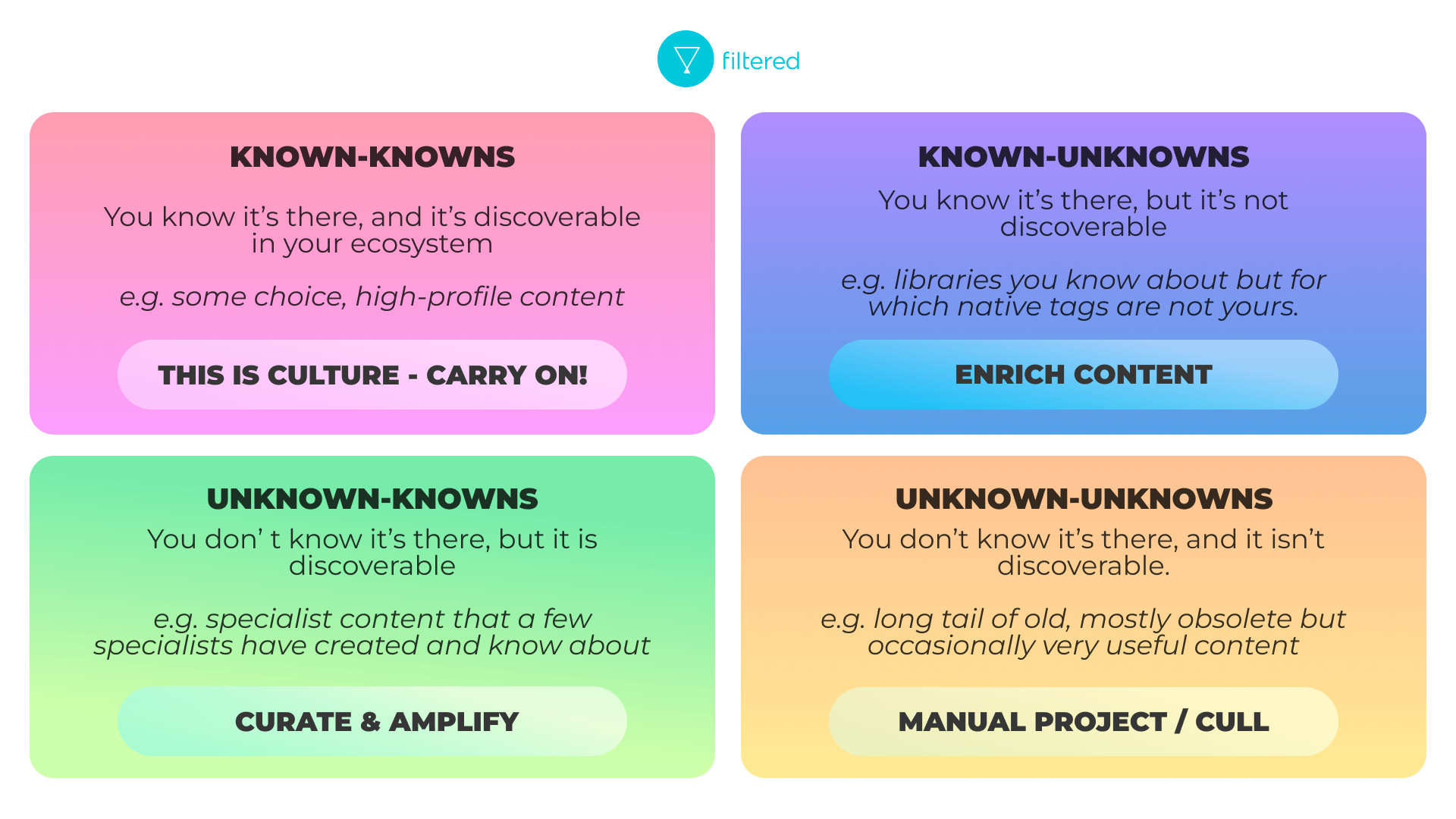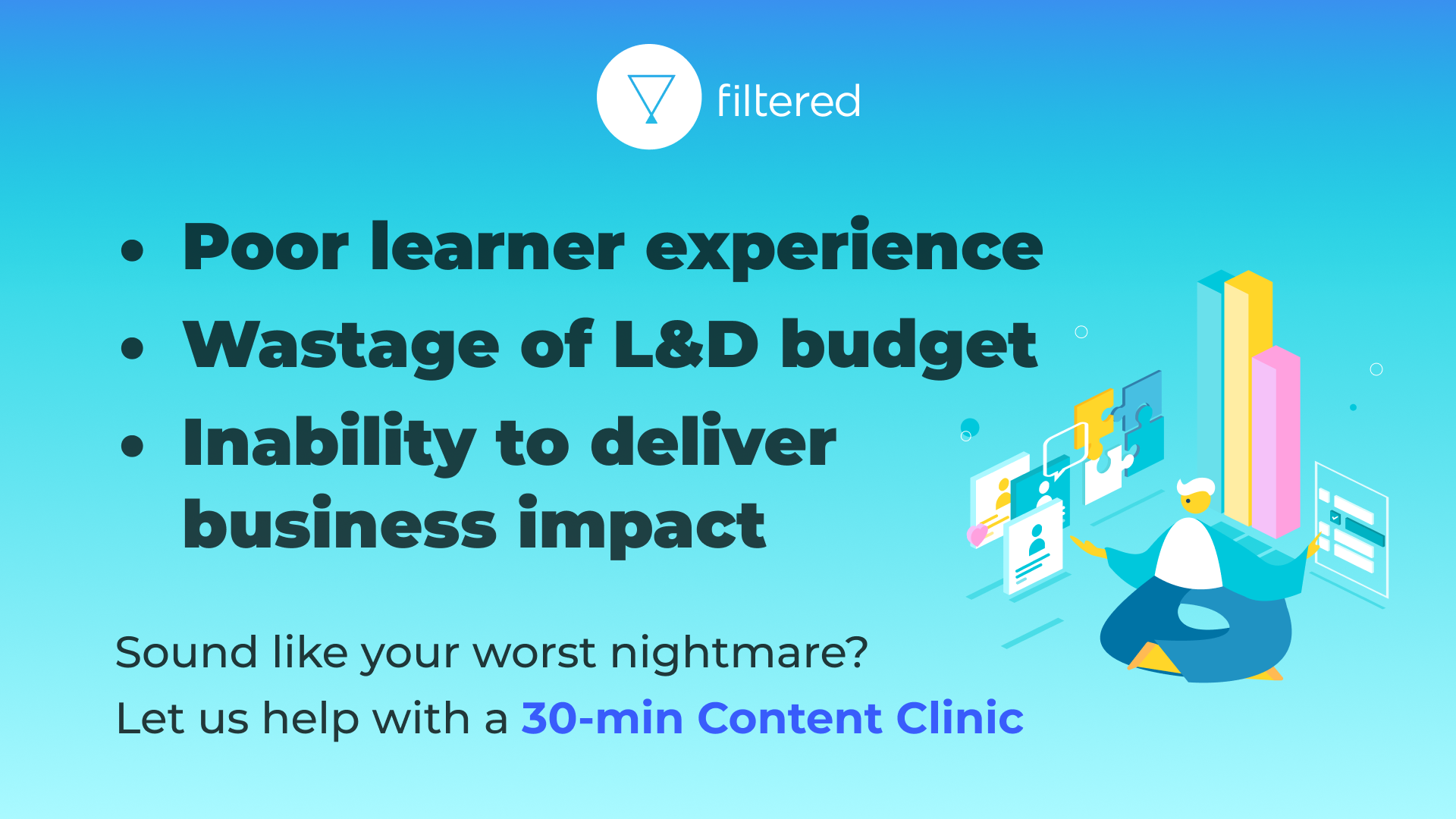|
TL;DR: The content dilemma can easily overwhelm L&D. The answer is prioritising needs regularly and quickly, which enables L&D to experiment, measure the effects and then move on at speed. You can prioritise needs with a good conversation, supported by some data, in which the right questions are asked. The four areas you need to address to tackle content strategy are 1) pains 2) skills (and other ways of looking at content) 3) the content itself and 4) data and tech. |
Good strategy is about making choices.
A vision of excellence is not enough. We also have to choose what we will do well, and what to say no to safely.
Learning content strategy is no different.
There is no limit to the amount of content that might be requested or created in any large organisation. We can technically cope with ever greater and more complex content loads thanks to the tech at our fingertips. But even then, we can’t treat all with the same level of care.
If you want to source, highlight, curate and communicate only the content that is likely to create a lot of value, you will have to prioritise some needs over others.
But prioritising needs doesn’t have to be a months-long exercise.
In fact, the length of time it can take learning organisations to decide on their top priorities has become a problem. Prioritisation can be…
Too slow: We’ve all heard the stories about elaborate skill taxonomies that take six months to complete and then sit unused because the external factors driving strategy have drastically changed in the meantime.
Not done at all: It can feel better to be as agile in response to business needs as possible. But of course, saying yes to nearly everything doesn’t make L&D any more agile. In that scenario, the roadmap to launch anything is also six months long because of all the work. Hard choices return.
The alternative to both protracted immersion in skill taxonomies and transactional chaos is to be decisive, but faster.
Prioritising needs regularly and quickly enables L&D to experiment, measure the effects and then move on at the speed of external change. If you are familiar with Agile methodology, this will sound familiar. And you will also know that the essence of Agile is constant prioritisation.
And we think that the cornerstone of that process is a good conversation, supported by some data, in which the right questions are asked.
This article aims to help you to do that with a map to a 90-minute conversation which prioritises needs by asking key questions in four areas:
- Pains
- Skills+*
- Content
- Data and tech
Answers to the key questions in these areas can form the map of your learning content strategy.
*Why skills+, not skills? Because knowledge topics, values and behaviours are all important lenses on learning content (and any content)
Who should be in this conversation?
The key roles flow from the four areas. Good, decisive meetings don’t usually feature more than four or five people, so try to keep it to one person, max two, per area:
- Pains - you (the learning content strategist) need business representatives from the target audiences. The shopfloor perspective can be as important as the C-level. Perhaps they are only ‘in the room’ virtually, as a recording or research (see below) but hear them!
- Skills+ - include one expert on skills and knowledge taxonomies in the organisation.
- Content - you should be the expert on this, drawing on advice from vendors.
- Data and tech - try to bring in your internal product manager/learning tech geek, or one of your more innovative vendors to help with technical challenges and questions.
Pre-work
Consider pains, skills+, content & data/tech
Everyone should consider the four main agenda points and note up a doc with thoughts, queries, resources and ideas. We’ve known since 1976 that meetings where we read an agenda in advance are far more productive than meetings where participants turn up blind.
Assemble some data on the pains
It’s notoriously difficult to be even and fair about business pains and even business objectives. You and your participants would do better if you assembled some data. But you don’t need to be comprehensive or go back very far in time.
Two to three data sources, giving a recent snapshot into the areas below, are perfect:
- What is the evidence for bottom-up demands for self-led learning base on day-to-day business challenges? Sources for this data include: data analytics from your content vendors, talent systems, job specs and LMS or LXP search data.
- Now what are the development priorities that flow from your business objectives? Sources include: what the CEO is saying, sector horizon reports produced by large consultancies and the executive summaries of annual reports or business plans.
Data in hand, agenda prepped, you’re ready to prioritise needs.
How to have the conversation
1. What are the pains you’re going to address?
Start with what hurts rather than a grand vision. There’s no set route to determining the problem that should drive your learning content strategy, but these questions might help:
- What's the big issue? Is it data, skills, time, employee experience, ROI?
- How is L&D viewed in the organisation?
- How many people in the business have a part-L&D remit?
|
ℹ️ Dr. Carrie Graham (She/Her), Adult Learning Consultant & Instructional Design Strategist, on content strategy and the importance of questions about the end user: When it comes to learning content strategy I never initially attack the content. Rather, I engage customers in a conversation about the end user. For example, recently in a large medical organisation that pushed a huge amount of compliance training on every team member, I asked: what are the values of the organisation and how do those match with the learning experience for your people? Invariably, clients are unable to answer deep questions about the end users, about their lives, challenges and aspirations. In fact they are creating content and learning experiences in the absence of this critical information. It’s this conversation about the end user - the person - that allows me to start to audit the content and the way things are designed and built. I'm still waiting for the first day to have a client who I asked these questions to and they can give me a solid answer. |
2. What are your priority skills+?
We say skills+ because it’s not just skills that matter for learning content strategy. There are more than skills at stake. Skills determine what individuals can do. But values and behaviours determine how systems and teams work. And simple knowledge can be all important: information is what makes your systems go around, after all.
Review your considered pains (what's the big issue?), look at what the data on demand and strategy is telling you, and then write down all the resulting themes, paying no attention to whether they seem to be skills, values, topics or behaviours.
You need to agree the criteria for prioritising from this longlist. Consider:
- Relevance to demand now vs in the future: is this skill on the way in or out?
- Acuteness of demand: is this linked to a business problem that really hurts?
- Strategic relevance: does the skill correlate with objectives over the next five years?
ℹ️ How big should my list be?
A prioritised list of themes combines broad applicability with organisational focus. Each employee can relate their goals to the list. But like a good mission statement, the list is also succinct, particular and exclusive (it states what is not important as well as what is important).
The overall number is your guardrail here. Even very large organisations like P&G or AstraZeneca focus on no more than 70. Smaller departments must be able to focus on no more than 20 themes.
Follow up task: How do you define each of those?
You’re ready to assign the main action from the meeting: Define what each of those skills mean.
You need to establish what each skill means in the context of your business. Try to look for living, breathing data sources here rather than definitions that might have been written down and left on the shelf for many years.
👉 For example, search queries can reveal a lot about how people define things
|
📖 Worked example: GSK’s business skills framework. The business objective was “A skills framework that supports learners in the real-world performance of their roles, now and in the future”. Filtered took GSK’s existing business skills framework of 39 productivity skills as a starter framework. We ran this against several data inputs:
The research resulted in a prioritised list that required several changes to the start framework, such as breaking data analysis skills out into more specific sub-areas, and addressing significant gaps in the framework around the theme of partnership - especially partnership with external organisations - which had been identified as a significant business challenge. |
3. What is the content situation and what matters most to your organisation?
Now think about how your current content lines up against the pains and priorities you’ve identified. Where are the gaps?
You need to answer the following questions:
- Which content do you have (paid, internal, free)?
- Where does your content sit? (LXPs, LMSs, SharePoint, etc)
- Do you have a picture of which content is used and which is not?
- How do you measure the impact of your learning content?
- Which of these are most important to you?
-
- Format
- Languages
- Cost
- Quality
- Length
- Level
- Style
You can also categorise your content into a 2x2 matrix of knowns/unknowns to get a clearer picture of your content situation.

ℹ️ Be mindful of the relationship between the users and your content
Does your existing content support on the job learning? Is there enough variety? Of utmost importance is to consider whether your content is facilitating a culture of employee-driven learning. If not, why not?
4. What are your data and tech limitations?
Don’t forget the risks and limitations in your data capability and tech stack.
In order to make fearless data-driven decisions, it's vital to know how certain your measurements are - and that means acknowledging the gaps in your data.
Questions you need to answer:
- Are you able to use data to win arguments in the business today?
- What data would you like to have but can't access?
- What LXP do you have?
- What LMS do you have?
|
ℹ️ Worked example: How NatWest were able to make sense of their large content libraries NatWest have between 250,000 and 300,000 learning assets which presented a set of data-related challenges: 1) Identifying relevant content to meet business needs and 2) identifying duplicate content. |
Follow-up
First, execute on the action to come up with a nuanced definition for every skills+ you prioritised.
You have the prioritised needs for your content strategy.
This conversation is best held with a vendor who can support your learning content strategy, like Degreed or Filtered. In fact, we build exactly this kind of data-informed discovery in our sales, kick-off and quarterly review processes.
To strengthen your learning content strategy with expert help, you can book a Prioritise Needs conversation with us now.


